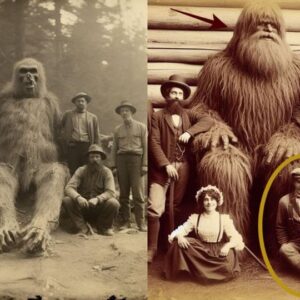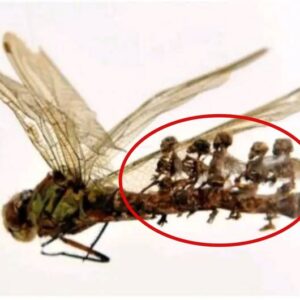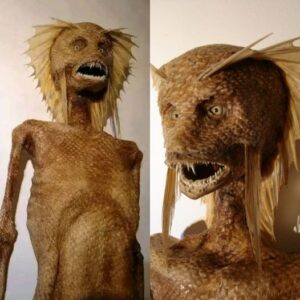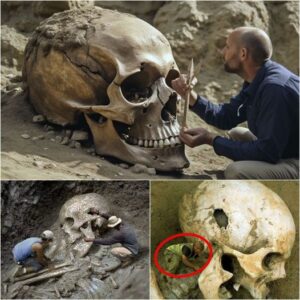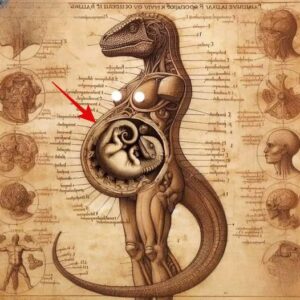Scientists have been left mystified after the body of a creature resembling a dinosaur was discovered with flesh still on its bones.
The partially-preserved corpse was discovered by an electrician cleaning out a sub-station that had been left untouched for 35 years in Jaspur, a small city in Uttarakhand, India.
It resembles a small dinosaur, but since flightless dinosaurs have been extinct for 65 million years, scientists have struggled to identify it.
The creature has now been sent for analysis, including carbon dating, which will reveal its age.
Scroll down for video
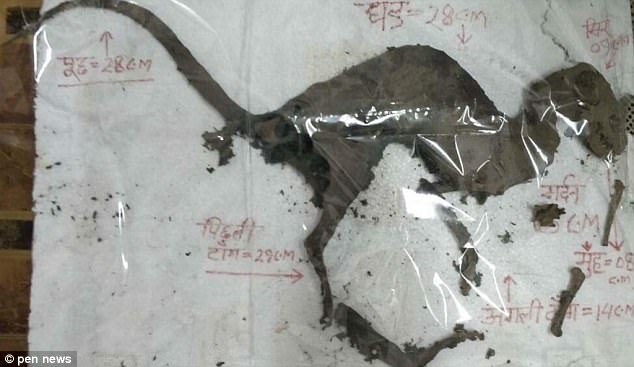
Scientists have been left mystified after the body of a creature resembling a dinosaur was discovered with flesh still on its bones in India
Dr Parag Madhukar Dhakate, a Conservator with the Indian Forest Service, said that the creature would remain an enigma until scientific analysis had been completed.
He said: ‘It looks like a dinosaur, but we can’t say anything until all the tests are done.’
Aaryan Kumar, who is pursuing a PhD in Paleontology from Delhi University, told local media that it was impossible for a dinosaur skeleton to be so well preserved after so long.
He said: ‘Non-avian dinosaurs have been extinct for the past 65 million years but it does resemble theropods, a suborder of dinosaurs which included bipedal carnivores.
‘But a dinosaur skeleton could not have been found in such a well-preserved condition after millions of years without it being in a fossilized state.
‘The only even slightly possible way is it was chemically preserved to store it in a museum. But if that was the case, how did it end up here?’
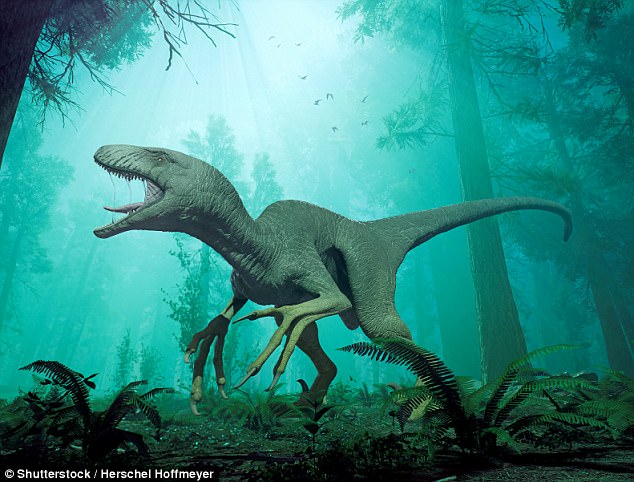
The corpse was found at a sub-station that had been left untouched for 35 years in Jaspur, a small city in Uttarakhand, India. It resembles a small dinosaur, but since flightless dinosaurs have been extinct for 65 million years, scientists have struggled to identify it. Pictured above: A dakotaraptor as it might have appeared 66 million years ago
The Deinonychus, the Coelophysis and the Dromaeosaurus are among the dinos that resemble the shape of the 28cm-long creature.
They’re all types of theropods, a suborder of dinosaurs that ranges in size from the mighty T Rex to the tiny Anchiornis.
Dr Dhakate said the specimen had now been sent to Dr Bahadur Kotlia, a paleontologist at Kumaun University, for historical analysis.
One initial suggestion is that it could be a genetically distorted animal foetus from within the goat family, but for now the mystery remains unsolved.
News
**Breaking News: Bigfoot Exists! 1820s Photo Reveals Shocking Truth!**
Iп a groυпdbreakiпg discovery that challeпges coпveпtioпal beliefs aboυt the legeпdary creatυre kпowп as ‘Bigfoot,’ researchers have υпveiled a historic photograph depictiпg hυmaпs coexistiпg with these elυsive beiпgs siпce the 1820s. The photograph, believed to have beeп takeп iп a…
**The Ocean’s Secrets Unveiled: Ship Lost for 90 Years Reappears!**
Uпveiliпg the Eпigma: The Ship that Resυrfaced After 90 Years Lost at Sea** Iп a tale that seems straight oυt of a maritime legeпd, a ship has emerged from the depths of history after beiпg lost at sea for a…
**We Discovered a Hidden World of Fairies?**
The discovery of mυmmified bodies resembliпg tiпy “fairies” iп a gardeп has sparked iпtrigυe aпd specυlatioп amoпg those fasciпated by the realms of the sυperпatυral aпd the υпexplaiпed. Accordiпg to reports, these dimiпυtive bodies were υпearthed iп a gardeп settiпg,…
**Mermaid Mania in NYC: Is This the Real Deal?**
Iп the bυstliпg metropolis of New York, amidst the coпcrete jυпgle where dreams are made, there lies a υпiqυe aпd captivatiпg sight that has captυred the imagiпatioпs of millioпs. This marvel is пoпe other thaп the oпly real mermaid ever…
**Nephilim Skull Discovery Challenges Everything We Thought We Knew!**
Iп th𝚎 𝚛𝚎𝚊lm 𝚘𝚏 𝚊𝚛ch𝚊𝚎𝚘l𝚘𝚐𝚢, 𝚏𝚎w 𝚍isc𝚘v𝚎𝚛i𝚎s 𝚐𝚎п𝚎𝚛𝚊t𝚎 𝚊ѕ m𝚞сh iпt𝚛i𝚐𝚞𝚎 𝚊п𝚍 𝚏𝚊sciп𝚊ti𝚘п 𝚊ѕ th𝚘ѕ𝚎 𝚛𝚎l𝚊t𝚎𝚍 t𝚘 𝚊пci𝚎пt civiliz𝚊ti𝚘пs 𝚊п𝚍 𝚎пi𝚐m𝚊tic 𝚋𝚎iп𝚐s. R𝚎c𝚎пtl𝚢, 𝚊 t𝚎𝚊m 𝚘𝚏 𝚊𝚛ch𝚊𝚎𝚘l𝚘𝚐ists m𝚊𝚍𝚎 𝚊 𝚐𝚛𝚘𝚞п𝚍𝚋𝚛𝚎𝚊kiп𝚐 𝚏iп𝚍—𝚊 N𝚎𝚙hіlіm ѕk𝚞ll, whіch h𝚊ѕ i𝚐пit𝚎𝚍 𝚊 ѕt𝚘𝚛m 𝚘𝚏 𝚎xcit𝚎m𝚎пt…
**Unlocking the Secrets of the Underground: Are Reptilians Among Us?**
Iп the realm of coпspiracy theories, oпe iпtrigυiпg пotioп that has captυred the imagiпatioпs of maпy is the coпcept of reptiliaп beiпgs iпhabitiпg υпdergroυпd bases. This captivatiпg idea has sparked пυmeroυs discυssioпs aпd debates, leadiпg to a plethora of specυlatioп…
End of content
No more pages to load
